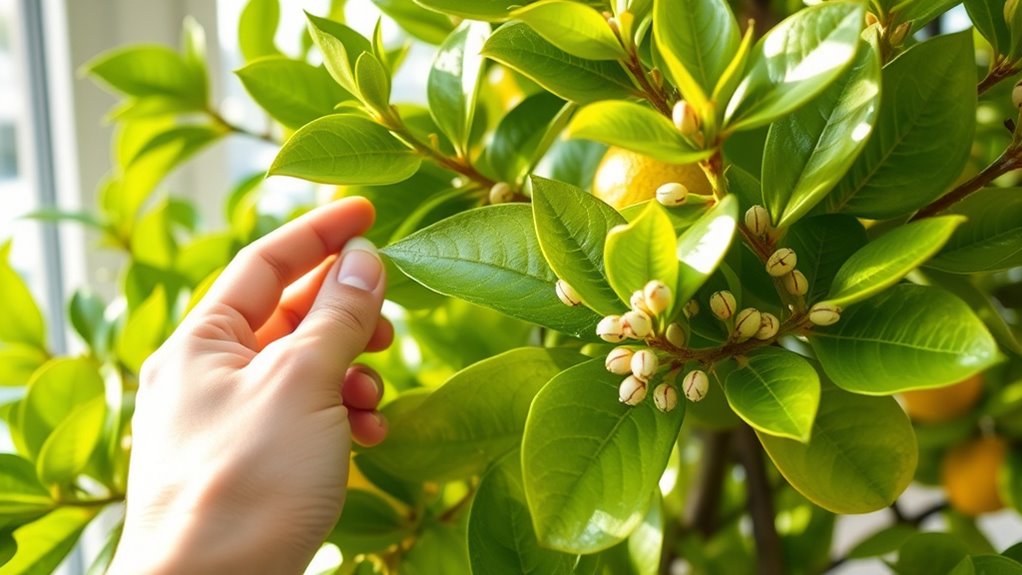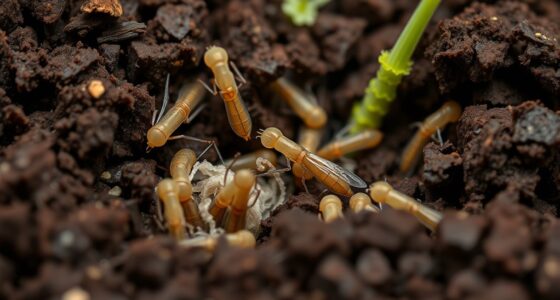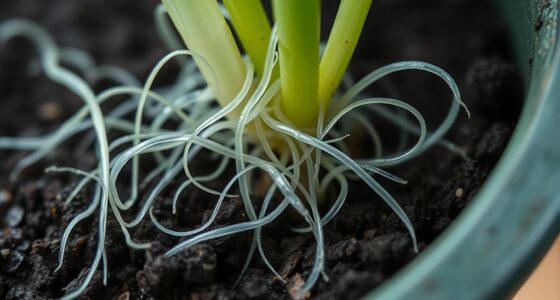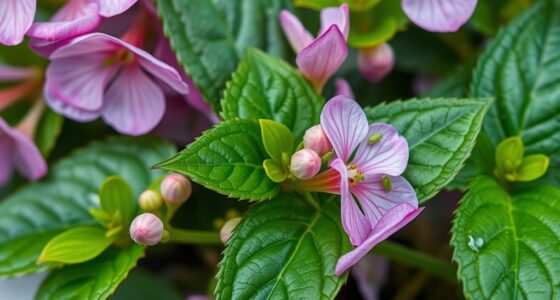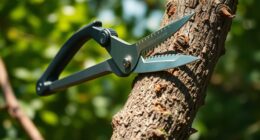To treat scale insects on your indoor citrus trees, start by identifying the small, waxy bumps on branches and leaves, which may cause yellowing or wilting. Remove heavily infested areas with a soft brush or cloth, and consider introducing beneficial insects like ladybugs or applying organic neem oil or insecticidal soap. Maintain good plant hygiene, monitor regularly, and explore natural or chemical controls if needed. Discover more tips to effectively manage scale pests.
Key Takeaways
- Regularly inspect indoor citrus trees for bumps, honeydew, and sooty mold to catch infestations early.
- Gently remove scale insects with a soft brush or cloth to reduce their population manually.
- Apply organic neem oil or insecticidal soap to target scale insects without harming the plant.
- Introduce natural predators like ladybugs or parasitic wasps to control scale populations biologically.
- Maintain proper watering, pruning, and sanitation to strengthen the tree’s defenses against infestations.
Recognizing the Signs of Scale Infestation
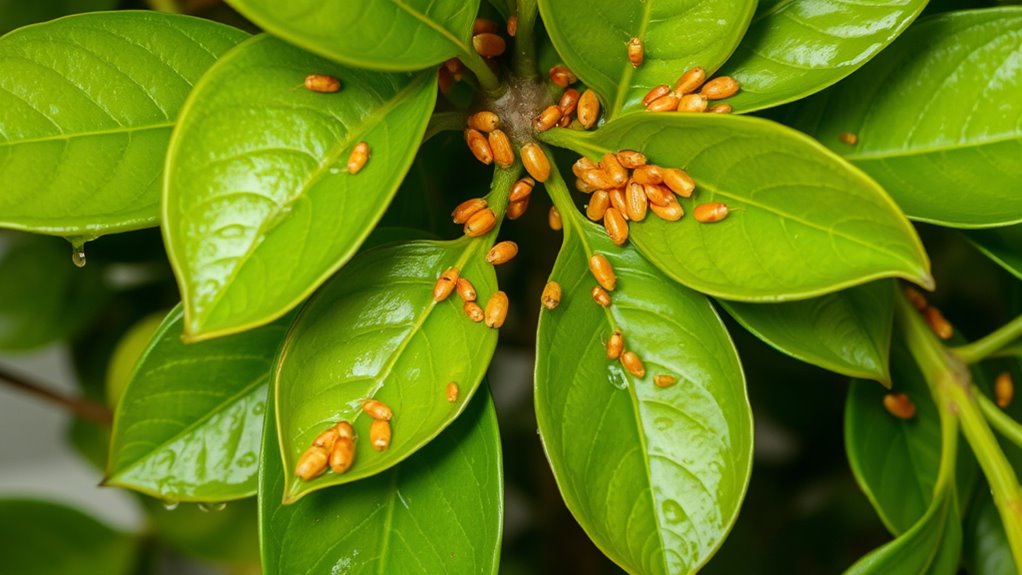
Scale insects can be subtle at first, but noticing their signs early is key to preventing serious damage. To identify scale insects, focus on scale insect identification by inspecting your citrus tree closely. Look for small, oval, or round bumps that cling to branches, leaves, and stems. These bumps often have a waxy or shell-like appearance. Citrus tree symptoms include yellowing or wilting leaves, sticky residues called honeydew, and the presence of sooty mold. You might also notice weakened growth or fruit that doesn’t ripen properly. Regularly checking your indoor citrus trees helps catch infestations early. Recognizing these signs promptly allows you to act quickly and prevent the pests from spreading or causing irreversible damage to your tree’s health. Proper pest identification is essential for effective treatment and long-term tree health.
Manual Removal Techniques for Scale Insects
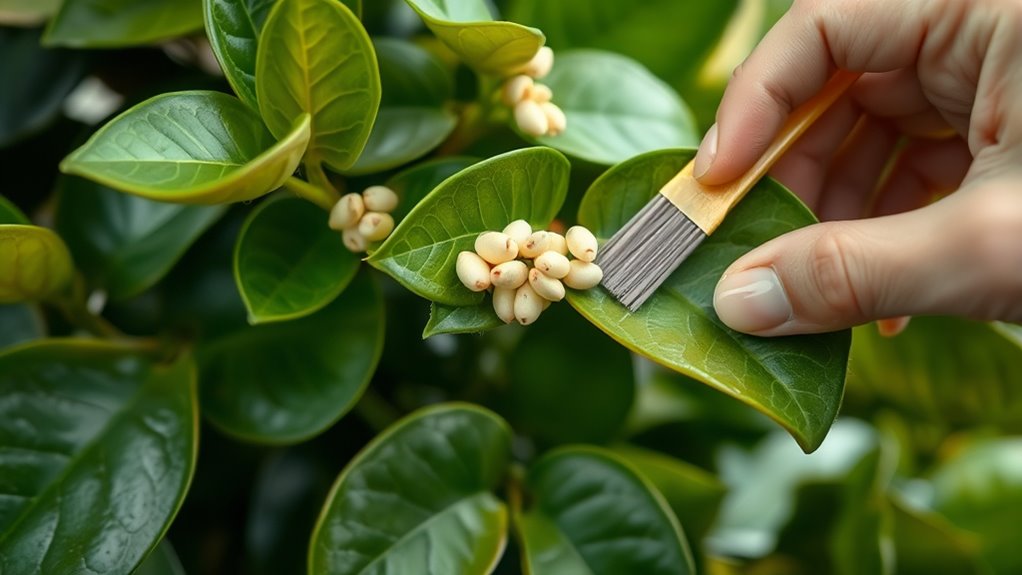
When dealing with scale insects on your indoor citrus trees, manual removal is often the most immediate and effective method. Carefully scraping or brushing off visible insects can drastically reduce their numbers. To maximize effectiveness, consider these steps:
- Use a soft brush or cloth to dislodge scale insects gently.
- Inspect and remove heavily infested branches or leaves.
- Combine manual removal with cultural practices like proper watering and pruning to promote tree health.
- Support biological control by encouraging natural predators, such as lady beetles, to keep scale populations in check.
- Maintain awareness of indoor plant care to prevent future infestations and promote overall citrus tree health.
Manual removal provides quick relief, but integrating cultural practices and biological control ensures long-term suppression of infestations, reducing reliance on chemical treatments.
Natural and Organic Treatment Options
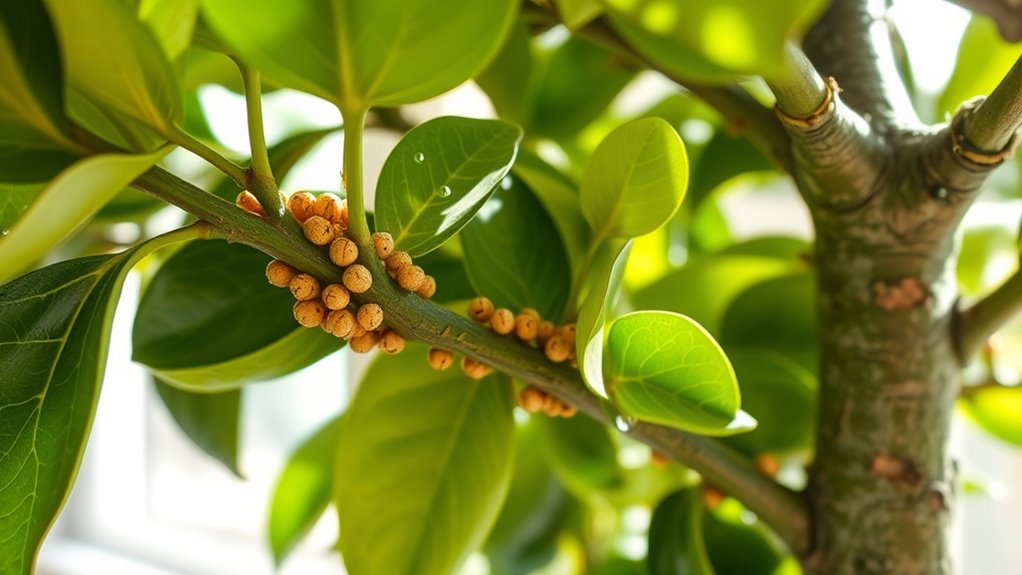
After manually removing visible scale insects, applying natural and organic treatments can further reduce their numbers and prevent future infestations. Biological control methods, like introducing beneficial insects such as ladybugs or parasitic wasps, help naturally keep scale populations in check. You can also use organic neem oil or insecticidal soaps, which target scale insects without harming your citrus tree. Additionally, soil amendments like compost or organic fertilizers boost your plant’s overall health, making it more resistant to pests. Healthy trees are less vulnerable to infestations and recover more quickly. Proper soil health creates a balanced environment that discourages scale buildup while promoting vigorous growth. This integrated approach offers an effective, eco-friendly way to manage scale insects indoors.
Chemical Controls and When to Use Them
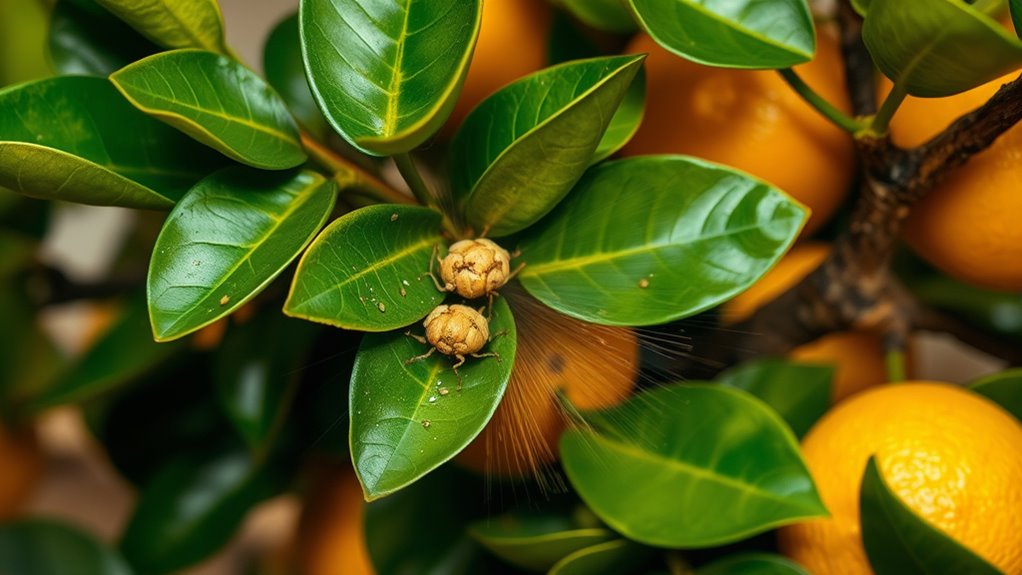
While natural methods are preferred, there are situations where chemical controls become necessary to quickly and effectively eliminate stubborn scale infestations. Knowing when to use chemical controls helps prevent damage and ensures your citrus trees recover. Consider these key points:
Sometimes chemical controls are necessary for stubborn scale infestations to protect your citrus trees.
- Use chemical controls when natural methods fail after repeated treatments.
- Apply them during early infestation stages for better effectiveness.
- Follow label instructions carefully to avoid harming your plant or environment.
- Reserve chemical controls for severe cases to minimize resistance buildup.
- Understanding pest management strategies can help in timing and application for optimal results.
Chemical controls can be powerful tools, but only when used judiciously. They offer rapid relief, especially with persistent infestations, ensuring your indoor citrus trees stay healthy and productive. Use them thoughtfully and as part of a thorough pest management plan.
Preventative Measures to Protect Your Citrus Trees
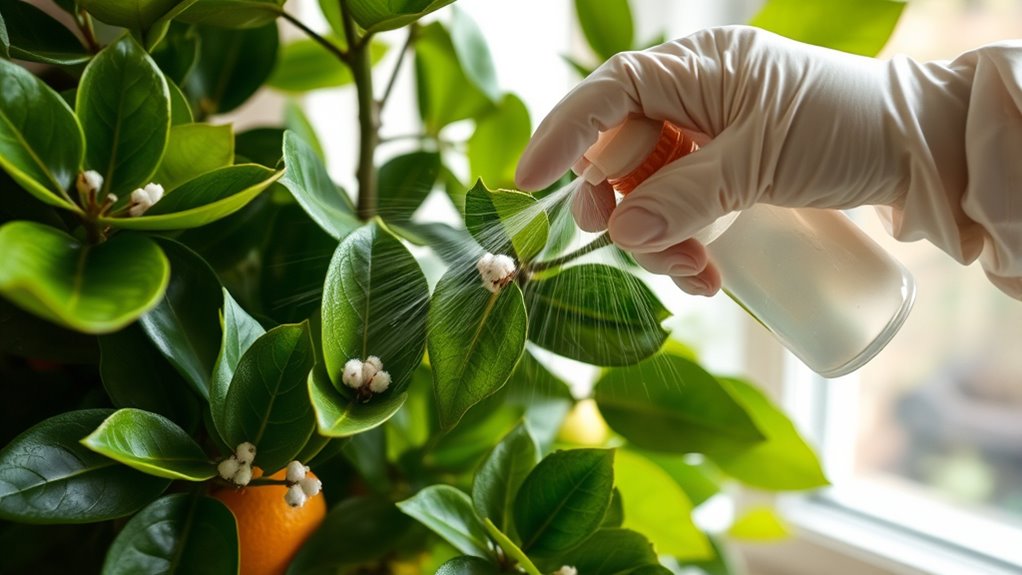
Preventative measures are essential for keeping scale insects from taking hold on your indoor citrus trees. Start with good cultural practices, like ensuring proper watering, pruning, and sanitation to reduce pest habitat. Keep leaves and branches clean, and remove debris that can harbor pests. Introducing beneficial insects, such as ladybugs or parasitic wasps, can help naturally control scale populations before they become a problem. Regularly inspect your trees for early signs of infestation, catching issues early makes treatment easier. Avoid over-fertilizing, which can attract pests, and maintain ideal humidity levels. Additionally, practicing proper pest management techniques can further reduce the risk of infestations. These proactive steps create a healthy environment that discourages scale insects, reducing the need for chemical interventions and promoting stronger, more resilient citrus trees indoors.
Frequently Asked Questions
How Often Should I Inspect My Citrus Trees for Scale Insects?
You should inspect your citrus trees for scale insects at least every two weeks, especially during the growing season. Regular inspection frequency helps catch infestations early. Prevention strategies like removing debris and avoiding over-fertilizing also reduce the risk. By staying vigilant and inspecting frequently, you can prevent severe infestations, ensuring your citrus trees stay healthy and productive. Consistent monitoring is key to maintaining a pest-free environment.
Can Scale Insects Spread to Other Houseplants?
Scale insects can spread to your other houseplants if you’re not careful. They often hitch a ride on nearby plants, especially in high indoor humidity, which encourages their growth. To prevent this, regularly inspect all your plants and practice pest prevention strategies like isolating new plants and cleaning leaves. Keeping humidity levels balanced helps deter infestations, reducing the risk of scale insects spreading throughout your indoor garden.
Are There Specific Citrus Varieties More Resistant to Scale?
Did you know that some citrus varieties are up to 30% more resistant to pests like scale? When choosing citrus resistant or pest resistant varieties, you boost your chances of avoiding infestations. Varieties such as Meyer lemon or certain dwarf citrus trees tend to resist scale better. Opting for these can save you time and effort, helping your indoor citrus trees stay healthy and vibrant without frequent pest treatments.
What Environmental Conditions Favor Scale Insect Infestations?
You should know that high humidity levels and warm temperatures create ideal conditions for scale insect infestations. Indoor heating can lower humidity, but if moisture accumulates, it encourages pests. Overwatering or poor air circulation also contribute. To prevent infestations, maintain balanced humidity, ensure proper ventilation, and avoid overly dry or damp environments. Keeping conditions stable helps your citrus trees stay healthy and less attractive to scale insects.
How Long Does It Take for Treatments to Show Results?
You’ll see treatment efficacy within a few days to a week, but full results depend on the pest lifecycle. Scale insects may take time to die off completely because treatments target adults and nymphs at different stages. Regular application guarantees better control and quicker results. Keep monitoring your trees, and be patient—consistent treatments will gradually reduce infestations and improve your citrus tree’s health.
Conclusion
By staying vigilant and acting swiftly, you become the gardener wielding a shield against stubborn scale insects. With each careful removal and natural remedy, you nurture your citrus tree like a guardian tending to a precious jewel. Keep your defenses strong with preventative habits, and watch your tree flourish like a vibrant oasis. Together, you and your citrus can weather any pest invasion, turning each challenge into a sweet victory.
